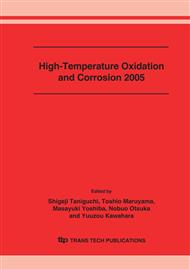p.119
p.129
p.139
p.147
p.155
p.163
p.171
p.181
p.189
The Effect of Gas Flow Rate on the Oxide Scale Morphology of a 10%Cr-Ferritic Steels in Ar-H2O and Ar-H2-H2O Mixtures
Abstract:
The oxidation behaviour of a Ferritic 10%Cr steel in Ar-H2O mixtures was investigated at 650°C. The studies aimed at elucidating the effect of water vapour content as well as the gas flow rate on the mechanisms of oxide scale formation. An important observation of the present investigation is, that H2 produced by the reaction of water vapour with the steel, can play a significant role in the oxidation process. It affects the possibility to form an external haematite layer and may alter the oxide scale growth rate. The extend by which the H2 affects the oxidation behaviour depends on the gas flow conditions, the water vapour content and the exposure time. To confirm these observations a number of specimens were oxidized in Ar-H2-H2O mixtures. This atmosphere guarantees a very low equilibrium oxygen partial pressure, in which H2 formed by reaction of the gas with the metal, does not substantially alter the thermodynamic properties of the gas.
Info:
Periodical:
Pages:
155-162
Citation:
Online since:
August 2006
Authors:
Keywords:
Price:
Сopyright:
© 2006 Trans Tech Publications Ltd. All Rights Reserved
Share:
Citation:


